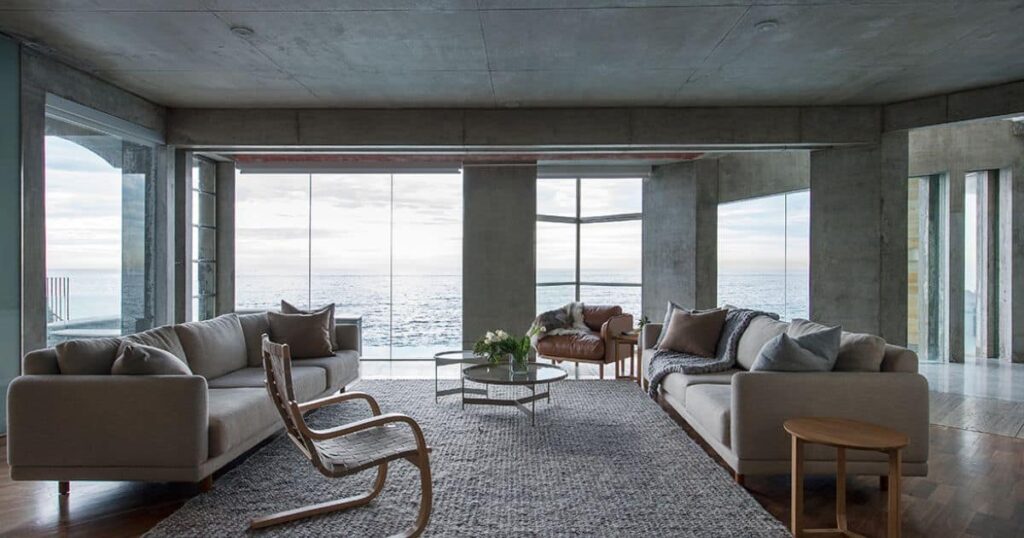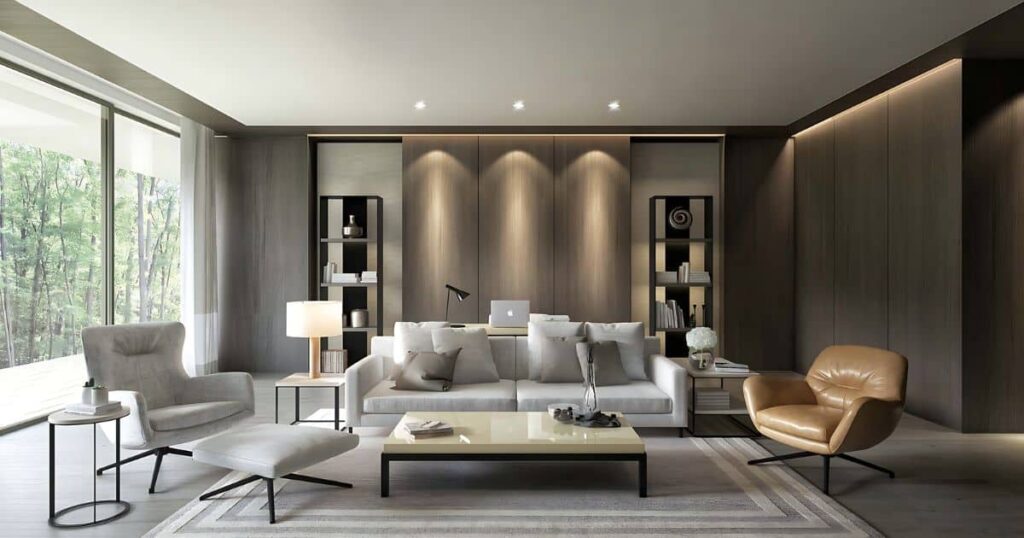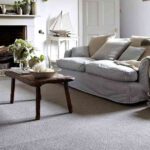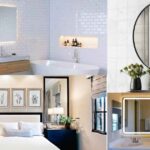Brutalist interior design celebrates raw, unfinished materials and surfaces. Hallmarks include exposed concrete, brick, and steel elements that showcase the bare essentials of construction.
The look embraces robust shapes, chunky furniture silhouettes, and earthy, monochromatic color palettes. Industrial accents and strategic lighting create stark contrasts and dramatic spaces.
This pared-down aesthetic strips away ornament to focus on form, function, and the innate beauty of basic materials. Though stark, Brutalist interiors counterbalance austerity with inviting textures and organic warmth for livable yet uncompromisingly honest design.
Historical Context of Brutalism
Brutalist interior design finds its roots in the post-war architectural movement of the same name. In the aftermath of World War II, architects sought to break away from overly ornate and excessive styles, embracing a more honest and utilitarian approach. The term “Brutalism” derives from the French phrase “béton brut,” which translates to “raw concrete” a material that became a defining element of this style.
Influential architects like Le Corbusier and Paul Rudolph popularized Brutalism through their iconic buildings, characterized by exposed concrete, bulky shapes, and a focus on functionality over aesthetic embellishment. As this architectural style gained traction, its principles soon made their way into interior design, offering a refreshingly raw and uncompromising alternative to conventional decor norms.
The Brutalist Architecture
Brutalist architecture is defined by its bold and uncompromising forms, often featuring:
- Exposed concrete as the primary material
- Bulky, geometric shapes and forms
- Emphasis on functionality over ornamentation
- Integration of structural elements into the design
Notable examples of Brutalist architecture include the Geisel Library at the University of California, San Diego, and the iconic Breuer Building at the UNESCO headquarters in Paris.
Brutalism in Interior Design
As the Brutalist architectural style gained popularity, its principles began to influence interior design trends. Homeowners and designers sought to break away from traditional decor norms, embracing a more raw and honest aesthetic that celebrated the beauty of unrefined materials and exposed structural elements.
Brutalist interior design offered a refreshing departure from the overly polished and ornate styles that had dominated for decades, allowing spaces to showcase their inherent authenticity and connection to the natural world.
Characteristics of Brutalist Interior Design

When it comes to Brutalist interior design, several defining characteristics set this style apart:
- Exposed Structural Elements: Rather than concealing beams, ducts, and pipes, Brutalism embraces these functional elements, incorporating them into the design as focal points.
- Rough, Unfinished Textures: Materials like exposed concrete, rough-hewn stone, and distressed wood are celebrated for their raw, unpolished beauty.
- Bold Geometric Shapes and Forms: Angular, blocky furniture and decor pieces, as well as sharp, geometric patterns, create a sense of visual interest and dynamism.
The Brutalist Color Scheme
The color palette in Brutalist interior design is characterized by its muted, earthy tones. Grays, browns, and beiges dominate, reflecting the natural hues of the raw materials used. Pops of bolder accent colors like deep reds, oranges, and mustard yellows can be strategically incorporated to add vibrancy and warmth.
Lighting plays a crucial role in enhancing the Brutalist color scheme. The strategic use of harsh, industrial-inspired lighting can create dramatic shadows and highlight the texture of the materials, while softer, natural light can soften the stark aesthetic.
The Use of Shapes and Lighting in Brutalism
Angular, blocky forms and innovative lighting designs are hallmarks of Brutalist interior design. Furniture and decor pieces often feature chunky, sturdy silhouettes with clean lines and minimalist aesthetics, creating a sense of sculptural beauty.
Industrial-inspired light fixtures, such as exposed bulbs or metal cage lamps, are commonly used to complement the raw, utilitarian vibe of Brutalist spaces. The strategic use of shadows and harsh lighting can further accentuate the textures and forms present in the design.
Read More:
Williams Sonoma Home: Sophisticated Style For Your Sanctuary
The Key Principles of Brutalism: Interior Design at its Most Raw

At its core, Brutalist interior design is guided by several key principles that celebrate the raw, uncompromising beauty of natural materials and functional design.
Natural Materials
One of the defining elements of Brutalism is the use of natural, unrefined materials in their purest form. Concrete, stone, wood, and steel are embraced for their inherent beauty, texture, and durability, creating spaces that feel grounded and connected to the natural world.
Colour Palette
The Brutalist color palette is dominated by neutral hues that blend seamlessly with the raw materials used. Grays, beiges, and warm browns create a sense of earthy sophistication, while pops of bolder accent colors can be introduced tastefully through textiles, artwork, or carefully curated accents.
Function & Comfort
While Brutalist interior design may appear stark and uncompromising at first glance, it prioritizes functionality and comfort above all else. Spaces are designed to be livable and practical, with a focus on creating cozy, inviting areas within the overall minimalist aesthetic.
Furniture
Furniture in Brutalist spaces often features chunky, sturdy silhouettes with low-slung profiles. Clean lines and minimalist shapes are favored, creating a sense of visual continuity with the surrounding architecture and design elements.
Artistic Touches & Handcrafted Pieces
While Brutalism embraces a pared-down aesthetic, it also values the human touch and artistic expression. Incorporating unique, one-of-a-kind accents, handcrafted pieces, or bespoke artworks can add depth and personality to these spaces, creating a balance between raw beauty and thoughtful curation.
The Natural World
Despite its industrial and utilitarian roots, Brutalist interior design seeks to forge a connection with the natural world. Incorporating elements like indoor plants, skylights, and large windows can bring the outdoors in, creating a harmonious blend of man-made and natural elements.
6 Ways To Use Brutalism In Your Home Interior Design
If you’re drawn to the bold, uncompromising aesthetic of Brutalism, here are six ways to incorporate this style into your own living spaces:
1. Focus on Honest Design
One of the core principles of Brutalism is to celebrate honest design and expose the functional elements that are typically concealed. Consider leaving structural beams, ducts, and pipes visible, allowing them to become focal points in your spaces. Embrace materials in their raw, unrefined state, showcasing their inherent beauty and texture.
2. Use Blocky Forms
Angular, geometric shapes are a defining characteristic of Brutalist design. Incorporate blocky furniture pieces, geometric wall art, or even architectural elements like concrete or stone accent walls to create visual interest and a sense of sculptural beauty.
3. Channel “Rough” and Distressed Textures
Embrace the raw, unpolished textures that are central to the Brutalist aesthetic. Concrete floors, exposed brick accent walls, or distressed wood elements can add depth and character to your spaces, telling a story through their imperfections and signs of wear.
4. Show Your Metal
Brutalism often incorporates industrial materials like steel and metal, blending them with warm, natural elements like wood. Consider incorporating industrial-inspired lighting fixtures, metal accents, or even exposed steel beams or columns to bring a touch of edginess to your spaces.
5. Add Zing with Spikes and “Free-Form” Edges
While Brutalism is known for its angular forms, it also embraces unconventional silhouettes and free-form edges. Look for furniture or decor pieces that feature unexpected shapes, spikes, or jagged lines to add a sense of dynamism and visual interest to your spaces.
6. Create a Colour-Free Zone
One of the most striking aspects of Brutalism is its embrace of a neutral, monochromatic palette. Consider creating a “color-free” zone in your home, where textures, forms, and raw materials take center stage. Stick to a palette of grays, browns, and beiges, allowing the inherent beauty of the materials to shine through.
Also Read:
Exploring The Home Of Gabriel Swaggart: A Modern Preacher’s Haven
Frequently Ask Questions
What is brutalism design style?
Brutalism is an architectural and interior design style characterized by exposed raw materials like concrete, roughly textured surfaces, simple block-like shapes, and a celebration of structural elements.
What is the brutalist design approach?
The brutalist approach strips away ornament and embraces functional minimalism with an emphasis on humble materials, geometric forms, monochromatic color palettes, and asymmetrical compositions.
What is the brutalist design trend?
The brutalist trend in interior design rejects traditionally decorated spaces in favor of an industrial, utilitarian aesthetic featuring bare structural components, distressed textures, chunky furnishings, and deeply earthy tones.
What is modern brutalist?
Modern brutalist design takes the raw concrete and blockish shapes of classic brutalism but softens the look with warm wood tones, sleeker furnishings, and pops of color while maintaining an emphasis on honesty of materials.
What is the concept of brutalist interior design?
Brutalist interior design adheres to the concept of showcasing materials and structural elements devoid of artificial embellishment or apology for exposing the unrefined bones of architecture and construction.
Final Thought
Brutalist Interior Design is a bold, raw, and honest approach to home decor that draws inspiration from Brutalist architecture. Emerging in the mid-20th century, Brutalism is characterized by its use of concrete, steel, and glass, favoring functionality and simplicity over ornamentation.
In interior design, Brutalism emphasizes natural materials, a muted color palette, and geometric shapes, often incorporating rough and distressed textures. This style champions an unembellished, industrial aesthetic, focusing on the inherent beauty of materials and forms. Key elements include blocky furniture, metal accents, and a minimalist approach that creates a stark, yet striking, living environment.







